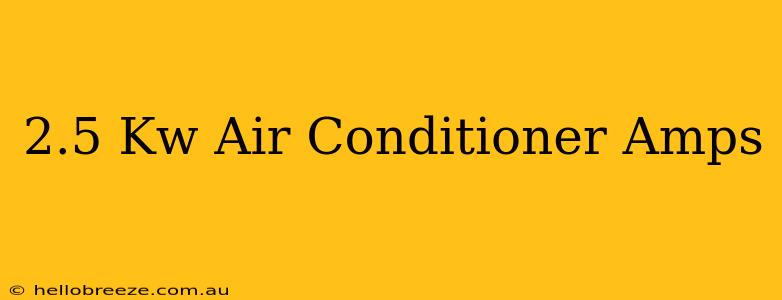Decoding the Amps: Understanding Your 2.5 kW Air Conditioner's Power Draw
Choosing the right air conditioner can be tricky, and understanding its power consumption is crucial. This guide focuses specifically on 2.5 kW air conditioners and helps you understand their amp draw. We'll break down the factors affecting amperage, calculate potential amp usage, and offer tips for energy efficiency.
What Does 2.5 kW Mean?
A 2.5 kW air conditioner means it has a cooling capacity of 2.5 kilowatts. This is a measure of its power to remove heat from a space. A higher kW rating generally means a more powerful unit, capable of cooling larger areas. However, the actual power consumption (measured in amps) varies.
Calculating Amps for a 2.5 kW Air Conditioner: It's Not That Simple!
You might think you can simply convert kilowatts to amps with a straightforward formula. While a basic calculation exists, it's not that accurate for air conditioners. The reason? Power factor.
The Basic (Inaccurate) Calculation:
A simplified calculation uses the formula: Amps = Watts / (Volts x Power Factor). Assuming a 230V system and a power factor of 1 (which is rarely the case for AC units):
Amps ≈ 2500 Watts / (230 Volts * 1) ≈ 10.9 Amps
Why This Calculation Is Flawed:
The power factor of an air conditioner is rarely 1. The power factor represents the efficiency of the AC unit in converting electrical power into cooling power. A lower power factor indicates less efficient energy use. A typical power factor for an air conditioner might range from 0.8 to 0.9. This means our simple calculation above significantly underestimates the actual current draw.
The More Accurate Approach:
To get a precise amperage reading, you need to consult the air conditioner's nameplate. This plate, usually located on the unit itself, provides the manufacturer's specifications, including the rated amperage. This is the most reliable way to determine the actual current draw.
Factors Affecting Amperage Draw:
Several factors can influence the actual amp draw of your 2.5 kW AC unit beyond the nameplate rating:
- Voltage fluctuations: Power supply voltage variations can directly affect the current draw. Lower voltage can cause the unit to draw more amps to achieve the same cooling power.
- Compressor efficiency: The compressor is the heart of your AC unit. A more efficient compressor will draw fewer amps for the same cooling output.
- Running conditions: The ambient temperature, humidity, and the size of the space being cooled all affect the compressor's workload and, consequently, the amperage draw. Hotter and more humid conditions will lead to a higher amp draw.
- Start-up surge: When the AC unit initially starts, there's a surge of current that can briefly exceed the rated amperage.
Tips for Energy-Efficient Operation:
- Regular maintenance: Cleaning filters and coils improves efficiency, reducing the amp draw.
- Proper sizing: Ensure your 2.5 kW unit is appropriately sized for the space you're cooling. An undersized unit will work harder and consume more energy (amps).
- Energy-efficient model: Look for an AC unit with a high Energy Efficiency Ratio (EER) or Seasonal Energy Efficiency Ratio (SEER) rating. Higher ratings indicate more efficient energy use.
Conclusion:
While a rough estimate of amperage for a 2.5 kW air conditioner can be made, always refer to the nameplate information for the most accurate data. Understanding the factors influencing amp draw helps you choose and operate your AC unit efficiently and safely. Remember, regular maintenance is key to maximizing efficiency and minimizing energy consumption!

